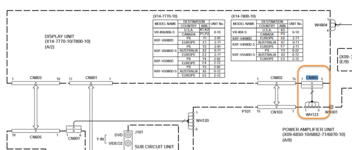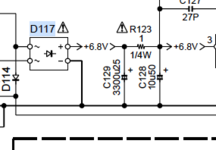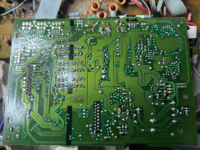mygoggie
Administrator
I spent way too many hours last night trying to find a correct replacement. Sigh ...
Hopefully one will come wondering in today
Hopefully one will come wondering in today
Welcome to the home for South African audio and visual equipment owners and enthusiasts. Whether you are an audiophile or a hobbyist, feel welcome to join us in the exciting discussions about amplifiers, turntables, receivers, speakers, projectors, screens, restoration and new projects, product reviews, accessories, classifieds, and so much more!
What does this power?The evening was spent retesting each removed component and then soldering the good functioning ones back in.
I found another problem! IC105 (a BA05T in a TO220FP package) which is a voltage regulator, is suppose to give a steady 5 VDC out as per the specification sheet.
View attachment 5374
If I look at the pins of the BA05T component it shown that pin 1 is on the left hand side:
View attachment 5375
If I look at the circuit diagram for the amplifier it shows that pin 1 is OUT. This is not matching with the specification sheet. See below.
View attachment 5373
If I look at the component diagram and the connections of IC105 to C127 and C125 and C128, then C128 is on the input side and C125 on the output side.
View attachment 5376
Comparing this to the way the IC was installed with the recess to the right hand side, it must mean that leg 1 is connected to C128 and leg 3 connected to C125.
View attachment 5377
This means that the circuit diagram is incorrect and leg 1 and 3 numbering are switched!
I tested the IC as per this diagram and it fails miserably in keeping voltage at 5V.
View attachment 5378
Will replace it as the output voltage and ripple removal function of this IC looks quite important.


Display inoperative I take then, ok not too bad. The input voltage to that VR ok?
Groetnis


Thanks for your continuous support. It means a lot!You're doing well, Herman, I love your meticulous posts to this thread.
-F_D



Thanks so much for this detailed explanation! Makes my searching quest so much easier and teaches me some more!My explanation above about the voltage driver for the STK chips was wrong.
It seems the STK chip gets +/-43.3V max on pins 12&13.
D305[10V]+D306[10V]+D319[11V]+D320[13V]-1*Vbe[0.7V]
It never gets +/-76V. The output stage does indeed switch between +/-46V and +/-76V (done independently by comparators inside the STK chip.) So the Output stage gets a lot more voltage than the stages driving it. Presumably this is done to account for significant voltage ripple on those +/-76V lines when driving many loads (in surround mode.)
So I'm thinking pin 12&13 see around +/-19.3 Volt during normal operation, when Q405 is on, and they get +/-43.3V via Q403/406 when a higher signal voltage requires it, as determined by the microprocessor (IC804 pin 74 controlling Q405).
This explains a couple of other things. +/-43.3V supplies on pin 12&13 should enable the output stage to deliver the specced ~100W in 6 Ohms. If the voltage amplifier bits could swing the STK chip's output stage to +/-76V the spec would have been closer to 400W per channel, and the amp would weigh a ton.
I'm slightly less worried about Q406 now. I can see it surviving switch-on without excessive C-E voltage and if Q402 switches on, effectively grounding the bases of Q406 & Q403, R996 should keep it alive.
About measuring the diodes, if you touch them they heat up to your body temperature, causing the forward voltage to drop. Same with transistors of course.
I've not come across dodgy diodes much. They always seem to fail with gusto, either open or short circuit. So either I've been very lucky, or I haven't been paying attention... I imagine applying max reverse voltage and checking for leakage (checking voltage drop across a resistor in series with the diode) is the failsafe check, One would need a pretty high supply voltage to do this for many of the common audio diodes. Not being a valve guy I'm nervous of having a kilovolt+ on the bench for those 1N4007s.
About the dry joints, I'm led to believe that all Lead-free joints look like dry joints. Never went Lead-free myself. While the principle seems nice enough I'm not convinced that the Lead-free move in the industry was a smart one. I got the explanation upstream wrong because of natural stupidity, not Lead poisoning. Now the obvious question is can one trust my opinion?
